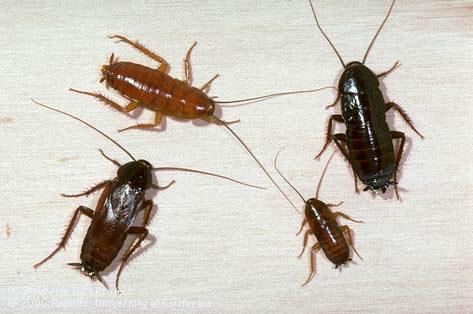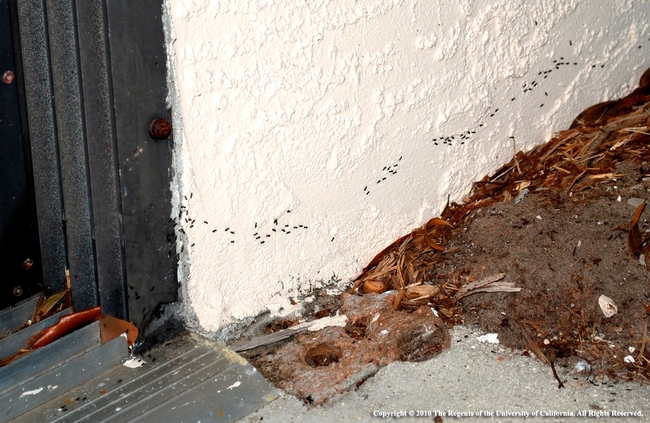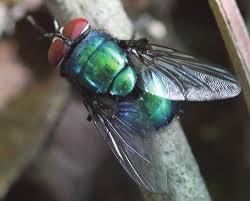
Cockroaches, ants and flies are three common outdoor pests that will enter homes when they have the opportunity, said UC Cooperative Extension urban integrated pest management (IPM) advisor Andrew Sutherland.
Oriental cockroaches, usually black or dark brown, are found throughout the U.S. They live and breed in dark, damp outdoor locations. Reddish-brown Turkestan cockroaches, originally from central Asia, are now well established in California. They live outside eating decaying plant and animal matter, finding safe harbor in water meter, irrigation and electrical boxes, cracks and crevices. American cockroaches live in warm and humid underground structures, such as sewers and storm drains.
If your home isn't well-sealed, they will walk right in.
Sutherland recommends using IPM strategies to prevent cockroach infestations, starting with prevention. Reduce moisture around the home, especially within the first couple of yards of the perimeter. Remove as much food as possible from around the home.
“You never want to leave pet food outside. If you have a fruit tree, make sure the fruit is not accumulating in the yard,” he said.
Add door sweeps or door brushes to close the gap underneath doors. Garages should be sealed with a flexible threshold seal.
“Spraying cockroaches with pesticides will not fix the problem,” he said. “If you have exterior doors with a one-inch gap, it doesn't matter how many pesticides you apply to cockroaches, they are still going to come in through the door. If you want to treat cockroaches with pesticides, bait works best.”
Readily available gel and granular baits are very effective.
Ants
Argentine ants are native to South America, but they have been introduced all over the globe. The tiny black insect lives in large colonies, so their trails can resemble crowded superhighways. Researchers have discovered that they tend to enter homes two times of the year: When the first rain of the season floods their nests, and when it is hot and dry in the summer.
“Sometimes they will even move their entire brood into a protected area indoors, within a wall or cabinet void,” Sutherland said. “Argentine ants live and breed outside. If you're seeing them indoors, it's because they are foraging on a resource or they're temporarily moving their colony to avoid inhospitable conditions.”
The best control strategy is prevention. Irrigated landscape favors Argentine ants. A drought-tolerant or xeriscape landscape will be less attractive to them. Removing food sources is more difficult with ants. Sap-sucking insects like aphids, mealybugs, whiteflies and soft scale deposit a sweet, sticky residue that ants love.
“If you're able to control the sap-sucking insects, you'll control the ants. Likewise, if you control ants, you'll probably see a reduction in sap-sucking insects,” he said.
Sutherland suggests avoiding regular pesticide spray programs for pest control because of the ecological damage that results when runoff flows into storm drains, creeks and other waterways. As with cockroaches, baits can be very effective.
“Ants are social insects. If an ant consumes a bit of insecticidal bait, it's going to share it with its nestmates. With baits you can actually kill an entire ant colony, where with sprays, at best you're going to kill the ants that cross chemical,” Sutherland said.
Sometimes, you might have an “ant emergency,” a swarm of ants that suddenly appears inside.
“There are safe steps to take,” Sutherland said. “I keep a spray bottle with a 10% soap solution. I spray it wherever I see ants and wipe them off. This works better than a contact insecticide because you also erase the pheromone trail the ants are using to find food or water. “

Many species of colorful metallic blowflies are found the world over. To control them, turn to prevention.
“Blowflies really like pet waste,” Sutherland said. “One deposit of waste can sustain a lot of flies. If you have pets, pick up and dispose of their waste.”
As a secondary control, be diligent with structural exclusion. Make sure the doors are closed, window screens are in good repair and screen doors fit well. You can buy aerosol cans of insecticide in home stores, which kills on contact as insects fly through mist. But it is cheaper and safer to kill them with a fly swatter or rolled up paper.
Learn more:
Summertime Household Pests, by Andrew Sutherland, UC IPM webinar on YouTube
UC IPM Pest Notes:
Cockroaches
Ants
Flies
Dozens of other pests